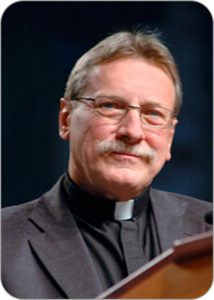
FROM THE PASTOR
The Endless Alleluia!
From the household gatherings of the early church, to congregations today, gathering around Word and Sacraments has been the form the Body of Christ takes in the world. A parish means that the walls of the church are permeable, not only the gathering of the beloved community within the walls, but also it’s community, it’s context. Our listening season at St. Luke’s is a parish listening season, within the walls, and out into the neighborhood.
Several years ago I was invited to preach back home at the parish in which I grew up, Grace Church in River Forest, Illinois. It is a large church in a substantial suburb. This congregations presents a monthly series of Bach cantatas. My sermon was to accompany Bach’s Easter cantata, BWV #4, “Christ lag in Todesbanden.” My faith was nurtured, my theological convictions formed, my sense of the centrality of Word and Sacraments was given to me by the parish of my youth. I first heard the music of Bach in that parish and remember climbing up to the organ loft to be with my father as he played the postlude after the liturgy. In that parish I learned to connect my faith and the mission of the parish to the pain and vulnerability of the world. I saw that suburban church live out mission with many inner city partners. In many ways my experience of St. Luke’s is similar: a suburban parish connected to global issues, justice issues emanating from the heartbeat of Word and Sacraments.
Cantata #4 could be a commentary on the faith life of the parish, which encompasses heartache and loss and disappointment, as well as deep joy. Our faith shines through the music. Bach’s music speaks universally to the soul, as I was reminded when a village choir in Tanzania sang a Bach chorale followed by a Bantu tribal tune set to a scriptural text. The text of the cantata gives no answers, just assertions. It begins with a beautiful orchestral sinfonia. Its flowing beauty is deceptive because the cantata is about the duellum mirabile, the strife between life and death that brought our salvation. The choir in fugue-like interchange and gradual crescendo asserts that Christ lay in the strong bands of death. Then, as if that doleful assertion mattered not at all, the choir simply asserts, in joyful acclaim, over and over again, “Alleluia, Alleluia, Alleluia….” So goes the rest of the cantata, wavering between death and life, despair and victory, each given their due, but always the last word belonging to the endless “Alleluia.” At the closing chorale the final “Alleluia” is declared with stunning clarity.
I believe that this duel between life and death, with the last word a resounding “Alleluia” can describe the life of the Christian parish. ”Your light shall shine,” said the prophet Isaiah to that ancient parish gathered in the breach of the walls of the city. The tune may change its key from parishes at the ruined ancient streets of Jerusalem, to River Forest and Park Ridge, to Lakeview and New York City. But the song remains the same. And Bach is one of a long line of artists who help us give voice to the song. In the words of a 5th-8th Century Latin text in the 1940 Episcopal hymnal:
Sing Alleluia forth in heartfelt praise,
You citizens of heaven, O sweetly raise
An endless Alleluia.
Then let the holy city raise the strain,
And with glad songs resounding wake again
An endless Alleluia.
Such song is rest and food and deep delight
To saints forgiven; let them all unite
In endless Alleluia.
Almighty Christ, to you our voices sing
Glory for evermore; to you we bring
An endless Alleluia
From the Parish for the Life of the world.
Pastor Stephen Paul Bouman

